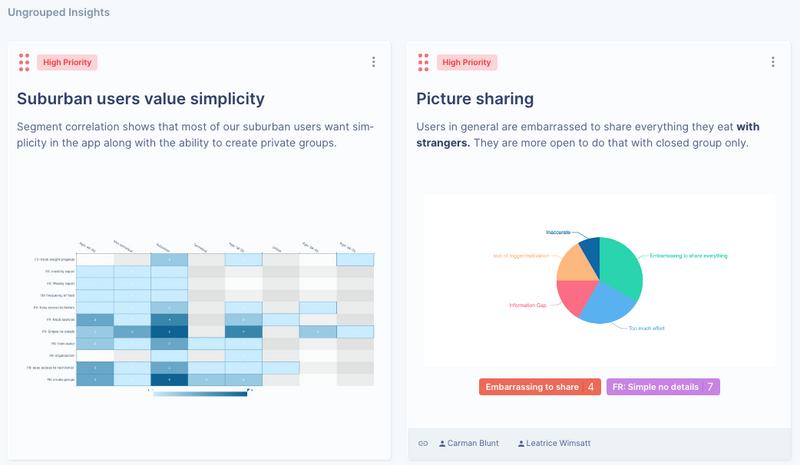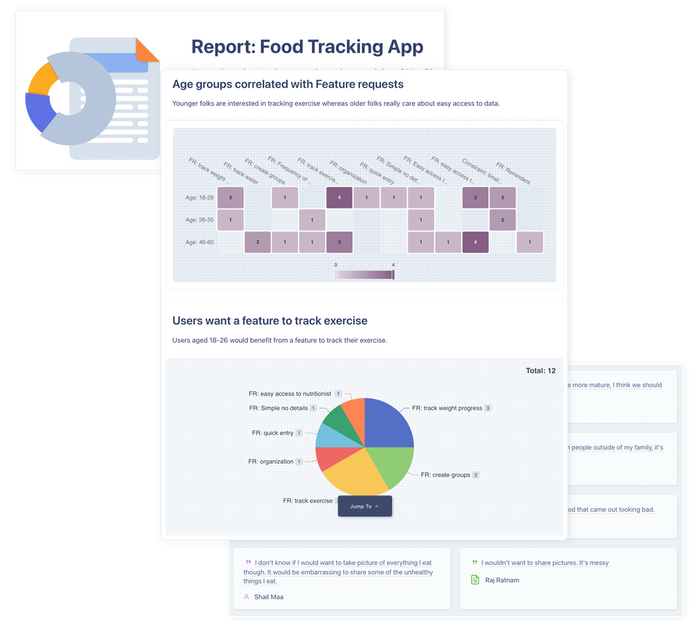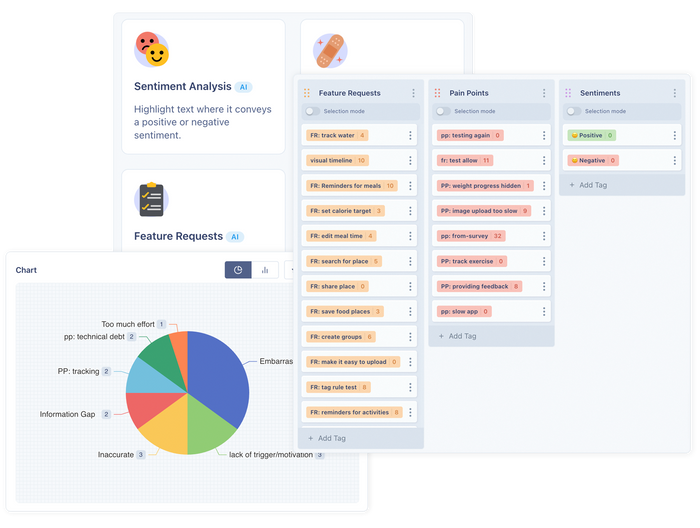
What is Atomic Research in UX?
Atomic Research in UX allows us to gain a thorough understanding of user data by breaking it down to its most elemental form. This method, often likened to a scientific approach, involves dissecting complex user interactions and feedback into the smallest units - the atoms of user experience, also known as atomic research nuggets. This approach is sometimes referred to as the atomic method.
In Atomic Research, every small piece of data, whether it’s a single user comment, a specific behavior observed during testing, or a particular pattern in user interactions, is significant. These granular insights are like puzzle pieces that, when pieced together, offer a comprehensive picture of the user experience. The goal here is not to get lost in the sea of data but to find those nuggets of insights that can drive meaningful design decisions.

Why does Atomic Research matter?
Atomic Research provides a dynamic approach to keeping up with qualitative data where user preferences and behaviors are constantly shifting. By focusing on these micro-elements, UX professionals can adapt more rapidly to user needs, ensuring that products and services are functional and truly resonate with the end-user. It’s a forward-thinking approach that aligns perfectly with the agile and user-centered ethos of modern UX design.
However, managing and interpreting the vast amounts of data in Atomic Research can be daunting. This is where products like Repository & Analytics by UserBit come into play. Their research repository provides a structured and efficient way to tag, organize, and analyze data, turning what could be an overwhelming amount of information into actionable insights.
In this article, we explore the nuances of Atomic Research and its practical application in the field of UX. We’ll see how, with the right approach and tools, Atomic Research can be highly effective in understanding and improving the user experience.
As the digital landscape grew in complexity, the need for a more detailed and granular approach became apparent.
Fundamentals of atomic user research
Atomic Research in UX is grounded in the principle of breaking down user research into its most basic elements or "atoms". This section will explore the key concepts and components that constitute Atomic Research, helping you understand how to apply this approach to your UX research practices.
Atoms, molecules, and organisms
Atoms: In Atomic User Research, an "atom" refers to the smallest unit of user data or insight. This atom could be a single user comment, a specific interaction with a product, or an individual user behavior. Atoms are the raw, unprocessed data collected from various research methods.
Molecules: When these atoms are grouped based on similarities or themes, they form "molecules". Molecules represent a more organized set of data that begins to reveal patterns and trends in user behavior. They provide a clearer picture of how individual insights are interconnected.
Organisms: At the highest level, "organisms" in Atomic Research refer to the comprehensive interpretation of these data molecules. Organisms are formed when molecules are analyzed and synthesized to provide actionable insights and strategic direction for UX design.
The process of breaking down complex user data
The process starts with collecting diverse user data through methods like interviews, surveys, and usability testing. The next step involves meticulously dissecting this data into atoms. This requires a keen eye for detail and an ability to discern the significance of every piece of information, no matter how small.
Examples of atomic research elements
Examples of atomic elements in UX research might include:
-
A user’s specific feedback about a feature.
-
Observations of how a user navigates a website.
-
A particular phrase or term frequently used by users in feedback sessions.
Once the atomic elements are identified, the next important step is organizing and categorizing them. Organizing atomic elements involves grouping similar atoms into molecules and then interpreting these molecules to form organisms. The organization of data is key to making atomic research practical and actionable.
Synthesizing atomic insights into actionable UX strategies
The final and most critical step in Atomic Research is understanding the broader implications of atomic insights and how they can inform design decisions. Synthesizing atomic data often requires a holistic view of the user experience, ensuring that even the smallest insights are considered in the context of the overall product strategy.
In the next section, we’ll understand the methods and best practices for conducting Atomic Research and how tools like UserBit can facilitate the effective management and synthesis of atomic insights.
Conducting atomic research in UX: methods and best practices
Atomic Research in UX involves a meticulous process of gathering and analyzing the most granular user data. Let's look at some effective methods and best practices for conducting Atomic Research.
1. Research methodologies suitable for atomic research
User interviews: Detailed interviews with users can uncover a wealth of atomic insights. Paying attention to specific phrases, reactions, and behaviors during these interviews can reveal valuable atoms of information.

Surveys and questionnaires: Surveys, especially those with open-ended questions, can elicit detailed responses that provide atomic insights.

Usability testing: Observing users interact with a product can yield atomic insights about user behavior, preferences, and pain points.
2. Strategies for identifying and extracting atomic insights
Active listening and observation: During interviews and testing, active listening and careful observation are crucial for identifying atomic insights.

Data mining: Analyzing large sets of user data, like logs or analytics, can uncover hidden atomic insights.

Note-taking and documentation: Rigorous note-taking and documentation during all research phases ensure that no atomic insight is lost.

3. Organizing and categorizing atomic data

Thematic analysis: Grouping atomic insights based on themes or categories helps in organizing the data effectively.
Use of tagging and coding: Implementing a system of tagging or coding helps in categorizing insights for easy retrieval and analysis
Leveraging tools: Utilizing tools like UserBit can streamline the process of organizing and categorizing atomic insights, making the analysis more efficient and manageable.
4. Turning atomic insights into UX strategies
Interpreting data: Understanding the broader implications of atomic insights is key to informing UX strategies.
Creating user personas and journey maps: Atomic insights can be used to create detailed user personas and journey maps.
Iterative design: Using atomic insights for iterative design allows for continual refinement and enhancement of the user experience.
So this is good in theory, but to use the research effectively we need to explore how these atomic insights are practically integrated into UX design and strategy.
Integrating atomic research into UX design and strategy
Atomic Research provides a wealth of detailed insights, but the true value lies in effectively integrating these insights into UX design and strategy. This section outlines how atomic insights can be translated into actionable design decisions.
Creating detailed personas: Atomic insights help in creating highly detailed and accurate user personas. By understanding specific behaviors and needs, personas become more representative of the actual user base.

Refining journey maps: User journey maps can be enhanced with atomic insights, pinpointing exact moments of user delight, frustration, or confusion, leading to more targeted improvements in the user experience.

Design decisions based on atomic insights: Presenting case studies where atomic research led to significant design changes demonstrates its practical impact. For instance, a small change in a user interface element based on user feedback might lead to a substantial increase in user engagement or satisfaction.
Strategic shifts: Discussing instances where atomic insights led to shifts in product strategy or the introduction of new features can illustrate the broader strategic impact of this research method.
Aligning insights with business goals: It’s important to align atomic insights with overall business and product goals. This alignment ensures that the insights are not just interesting, but also actionable, and relevant to the product’s success.
Prioritization of insights: Given the volume of data generated in Atomic Research, prioritizing insights based on their potential impact on user experience and business outcomes is essential.
Effective communication: Clearly communicating atomic insights to stakeholders is vital. Clear communication involves presenting the insights in a digestible format, often using visual aids or storytelling techniques to highlight their significance and potential impact.
Collaboration with design and development teams: Ensuring that designers and developers understand and can act on these insights is key to their successful integration into the product design.
Iterative design process: Atomic Research supports an iterative design process, where insights from each iteration inform the next, leading to continuous improvement in the user experience.
Feedback loops: Establishing feedback loops where user reactions to changes are continuously monitored and fed back into the research process ensures that the product evolves in line with user needs and preferences.
Challenges and solutions
So far so good, but like any other methodology, Atomic research also has some challenges that we need to be mindful of. Let's address common obstacles faced in conducting and applying atomic research, along with strategies and best practices to overcome them.
1. Managing overwhelming amounts of data
One of the primary challenges in Atomic Research is the sheer volume of data generated. Sorting, analyzing, and synthesizing this data can be overwhelming.
Solution: Implementing robust data management and organization systems is essential. This may include using advanced data analysis tools, categorizing insights effectively, and employing methods like thematic analysis to manage large datasets.
2. Ensuring data quality and relevance
Ensuring the quality and relevance of each atomic insight can be daunting. There's a risk of getting lost in details that may not significantly impact the overall user experience.
Solution: Establish criteria for evaluating the relevance and impact of insights. Regularly reviewing and updating these criteria helps maintain focus on insights that offer the most value.
3. Integrating atomic insights into broader UX strategies
Translating granular insights into actionable strategies can be complex. It requires not just understanding the insights but also how they fit into the bigger picture of user experience.
Solution: Collaborate closely with design and strategy teams to ensure insights are integrated effectively. Develop a systematic approach to translating atomic insights into design principles and strategic decisions.
4. Communicating insights to diverse stakeholders
Articulating the significance of detailed insights to stakeholders unfamiliar with Atomic Research can be challenging.
Solution: Develop clear, concise, and compelling ways to communicate insights, using visualizations or storytelling techniques. Tailor the communication to the audience's level of expertise and interest.
5. Keeping pace with evolving user needs
The dynamic nature of user needs and preferences means that atomic insights can quickly become outdated.
Solution: Establish ongoing research cycles and continuous feedback mechanisms to keep insights up-to-date. Embrace an iterative approach to design, allowing for regular updates based on fresh insights.

6. Balancing depth with breadth
Focusing too much on atomic details might lead to missing the broader context or overarching user experience trends.
Solution: While delving deep into studying atomic insights, periodically step back to view these insights within the larger context. Use a combination of atomic and more traditional research methods to maintain a balanced perspective.
Conclusion: fully embracing the potential of atomic research in UX
As we conclude our exploration of Atomic Research in UX, it's clear that this approach marks a significant shift in how we understand and cater to user needs.
Atomic Research in UX isn't just a methodology; it's a mindset that emphasizes the importance of every user interaction, no matter how small. As UX professionals, adopting this approach can lead to more insightful, effective, and user-friendly designs. In this journey of discovery and improvement, tools like UserBit can play a pivotal role, helping us to manage, analyze, and apply these granular insights with greater efficiency and impact.
As we close this discussion, let's remember that in the world of UX, the smallest details can often hold the key to the biggest breakthroughs.

